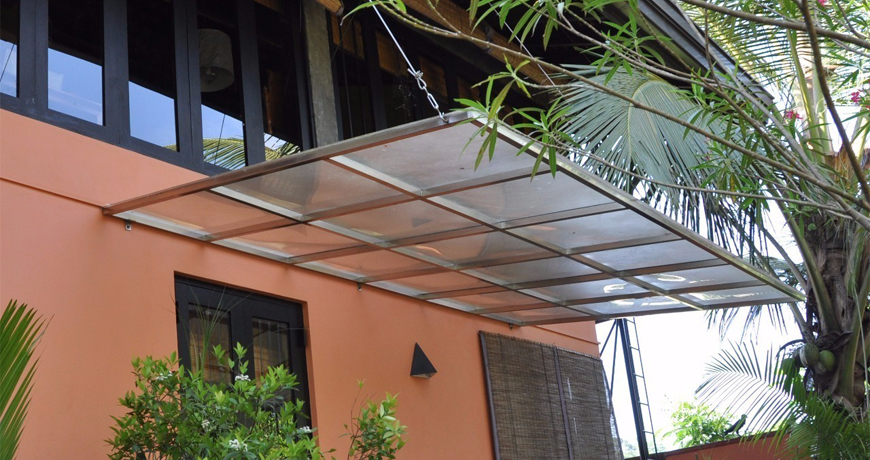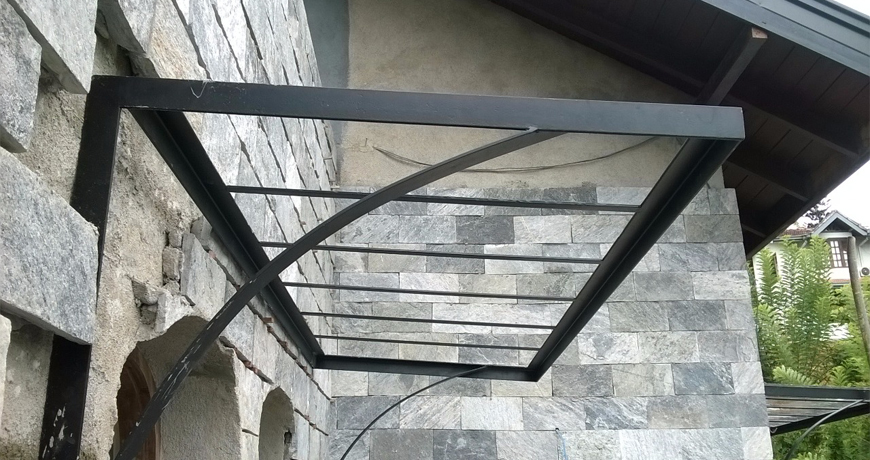Light and Solar Energy Transmission
Different applications using translucent polycarbonate sheeting call for varying levels of light transmission. With different colours these levels change.

Not only does the natural (or visible) light level vary, but the amount of solar energy (heat) also varies.
Polycarbonate is a thermoplastic with a high degree of clarity. Therefore the direct transmission of solar energy is considerably higher than that of a diffused panel. Consideration for the appropriate colour should therefore be carefully weighed up.
The diagram below depicts the approximate transmission of the various wavelengths of the light spectrum for a clear PC sheet.
More than 70 % of the heating effect of the sun is carried between 350 and 800 nanometres (generally, the visible light spectrum) and we can see that these wavelengths are generously transmitted through a clear polycarbonate sheet – more than 85%.
Color QUEST Colorimeter Test Results
| PC ROOF SHEET TINT |
CLEAR
|
BLUE
|
GREEN
|
OPAL 50
|
BRONZE
|
OPAL 10
|
| VISIBLE SPECTRUM (380 nm – 700 nm) | ||||||
| % Light Transmission | 90 | 65 | 40 | 50 | 40 | 25 |
| % Light Reflectance | 13 | 10 | 10 | 42 | 8 | 74 |
| SOLAR ENERGY (350 nm – 2100 nm) | ||||||
| % Rejected | 13 | 26 | 41 | 41 | 40 | 67 |
| % Direct Transmission | 87 | 68 | 47 | 57 | 47 | 31 |
| % Direct Reflectance | 11 | 8 | 8 | 34 | 7 | 63 |
| % Absorption | 3 | 24 | 44 | 9 | 46 | 7 |
| % Total Transmission | 88 | 74 | 59 | 59 | 60 | 33 |
| SHADING COEFFICIENT | 1.00 | 0.86 | 0.68 | 0.68 | 0.69 | 0.37 |
Heat Stop
Heat Stop is an innovative development in polycarbonate translucent roof sheeting. This product effectively eliminates 60% of the radiated heat of the sun, resulting in a cool shaded environment.
Heat Stop is a polycarbonate profiled extrusion, manufactured in South Africa, which has a co-extruded layer of UV stabilized surface protection on the weather side. Microscopic reflective particles are incorporated in the core material which creates the silver colour and the reflective qualities of the product.
If an application for a translucent roof sheet or skylight requires a minimum heat build-up under the natural light panel – Leland Industries offers a polycarbonate solution. It should be remembered, however, that a lower level of light transmission is achieved with Heat Stop. The appropriate surface area of translucent roof sheets must, therefore, be used to achieve the required interior light levels.
Heat Stop offers the following properties:
• All the excellent physical properties of polycarbonate.
• UV surface protection on the weather side.
• 20 % light transmission.
• It is available up to 2.0 mm profiles:
• UV surface protection on the weather side.
• 20 % light transmission.
• It is available up to 2.0 mm profiles:
Color QUEST Colorimeter Test results
| PC SHEET |
HEAT STOP
|
| VISIBLE SPECTRUM (380 nm – 700 nm) | |
| % Light Transmission | 22 |
| % Light Reflectance | 32 |
| SOLAR ENERGY (350 nm – 2100 nm) | |
| % Rejected | 60 |
| % Direct Transmission | 27 |
| % Direct Reflectance | 27 |
| % Absorption | 46 |
| % Total Transmission | 40 |
| SHADING COEFFICIENT | 0.46 |
Weatherability
Polycarbonate roof sheeting is manufactured using modern co-extrusion technology to create a highly UV stabilised weathering surface on the sheet.
This UV layer will not crack or delaminate, and ensures years of trouble-free performance in the harsh South African weather conditions.
As with almost all plastics, UV attack from the sun will, over a period of time, adversely affect polycarbonate roof sheets. This process is called photodegradation.
What occurs during this process is the following:
The aggressive short wavelength UV rays are absorbed into the polymer. They “excite” the chemical molecular bonds, causing them to separate, resulting in a slight yellowing and a reduction of physical properties such as tensile strength and impact resistance.
This process is significantly reduced in the polycarbonate sheet because of the excellent protection offered by the UV co-extruded layer which incorporates UV stabilisers and UV absorbers. Over a prolonged period, a slight yellowing or hazing will be detected in a polycarbonate sheet.
With outside exposure in normal conditions in South Africa, it is expected that a clear polycarbonate sheet with UV protection will not increase in yellowness more than 9 yellowness index units within ten years from date of sale.
The determination of the yellowing index will be made on samples subjected to pre-test cleaning and conditioning according to our test procedures, and the yellowness index shall be determined according to ASTM D-1925-70 as measured with Hunter Colour-Quest colour Spectrophotometer.
A Polycarbonate sheet will retain virtually all its physical properties, and remain structurally sound over this period of time, under normal conditions.
Corrosion and Medical Resistance
Our Polycarbonate sheets will resist chemical attack and corrosion in most industrial and marine environments.
Tests have found the following:
• Our Polycarbonate sheets is highly resistant to corrosion and high concentrations of mineral acids, many organic acids, oxidizing and reducing agents, neutral and acid salt solutions, many oils and fats, saturated aliphatic and cyclo-aliphatic hydrocarbons and alcohols.
• Our Polycarbonate sheets are not resistant to strong acids and alkalis, methyl alcohol, aromatic hydrocarbons and chlorinated hydrocarbons nor to lengthy immersion in hot water.
• Our Polycarbonate sheets must not be used in conjunction with plasticised PVC. This will result in stress corrosion cracking and cause damage to the Hough Group’s Polycarbonate PC sheet.
• Leland Industries Polycarbonate sheets are ideal for coastal applications.
• Our Polycarbonate sheets are not resistant to strong acids and alkalis, methyl alcohol, aromatic hydrocarbons and chlorinated hydrocarbons nor to lengthy immersion in hot water.
• Our Polycarbonate sheets must not be used in conjunction with plasticised PVC. This will result in stress corrosion cracking and cause damage to the Hough Group’s Polycarbonate PC sheet.
• Leland Industries Polycarbonate sheets are ideal for coastal applications.
The resistance to chemical attack varies with a wide range of chemicals, detergents, polishes and cleaning agents. This resistance chart refers to certain chemicals and the reaction of PC under certain conditions.
+ resistant – non-resistant
| CHEMICALS |
6 DAYS / 23 °C
|
| Acetic acid, 10 % in water |
+ |
| Hydrochloric acid, 10 % in water |
+ |
| Sulphuric acid, 10 % in water |
+ |
| Nitric acid, 10 % in water |
+ |
| Phosphoric acid, 1 % in water |
+ |
| Citric acid, 10 % in water |
+ |
| Sodium carbonate (soda), 10 % in water |
+ |
| Sodium chloride, saturated / aqueous solution |
+ |
| Sodium nitrate, 10 % in water |
+ |
| Ammonium nitrate, 10 % in water / neutral |
+ |
| Iron (III) chloride, saturated / aqueous solution |
+ |
| Potassium hydroxide 1 % in water |
– |
| Sodium hydroxide (caustic soda), 1 % in water |
– |
| Ammonia, 0.1 % in water |
– |
| Acetone |
Swells |
| Benzine (free from aromatic compounds) |
+ |
| Benzene |
Swells |
| Butyl acetate |
– |
| Chloroform |
Dissolves |
| Dibutyl phthalate |
– |
| Diethyl ether |
– |
| Dimethylformamide |
Dissolves |
| Dioctyl phthalate |
– |
| Dioxane |
Dissolves |
| Ethanol (pure) |
+ |
| Ethylene glycol, 1:1 with water |
+ |
| Ethylene chloride |
Swells |
| Ethyl acetate |
Swells |
| Ethylamine |
– |
| Glycerine |
Reacts |
| Isooctane (2.2.4-trimethyl pentane), pure |
+ |
| Isopropanol (pure) |
+ |
| Hexane |
+ |
| Methanol |
– |
| Methylamine |
Reacts |
| Methylene chloride |
Dissolves |
| Methyl ethyl ketone |
Swells |
| Ozone, 1 % in air |
– |
| Paraffin, paraffin oil, (Vaseline), pure / free from aromatic compounds | + |
| Perchloroethylene |
– |
| Perhydrol (hydrogen dioxide), 30 % in water |
+ |
| Propane |
+ |
| n-propanol |
– (30°C) |
| Styrene |
– |
| Silicone oil |
+ |
| Carbon tetrachloride |
Swells |
| Tetrachloroathane |
Swells |
| Trichloroethylene |
Swells |
| Tricresyl phosphate |
– |
| Triethylene glycol |
+ |
| Xylene | Swells |
Physical and Mechanical Properties
| Tensile Strength |
72 MPa – ASTM D-638 |
| Flexural Strength |
+92 MPa – ASTM D-790 |
| Modulus in Flexure |
+2400 MPa – ASTM D-790 |
| Thermal Movement |
+Coefficient of linear expansion (clear) 67 X 10-6m/°C. – ASTM D-696 |
| Water Absorption | 0.36% by mass after 24 hours at 20°C – ASTM D-570 |
| Hardness |
80 (°Shore D) |
| Drop Dart Impact Strength |
25 Nm (Gardner) |
| Thermal Conductivity |
0.2. W/mK – ASTM C-177 |
| Flammability |
V2 when tested to UL94 ratings. Whilst Polycarbonate sheets do burn, they are self-extinguishing and will not promote fire or assist spread of flame. |
Note that the very high impact resistance of Leland Industries Polycarbonate sheets makes them virtually unbreakable, and therefore makes them particularly suitable for use in high-risk areas where damage from hail, high wind loads or vandalism is likely.


